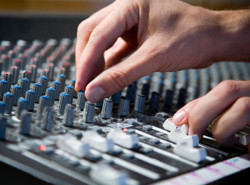If you’re a front of house mixer, here’s what you need to know about monitors. If asked to adjust monitor settings, look the person directly in the eye and say, “I handle front of house; I don’t do monitors.”
Speak it with authority and perhaps add a bit of disdain, then turn quickly and as you’re walking away add, “let me find the monitor mixer for you.”
At this point your job is done, unless of course, you actually happen to run across the monitor person. If so just say, “someone on stage is looking for you.”
Now let’s return to the real world.
Years ago, a band could be booked at a club three or four nights in a row; today, most clubs rotate bands on a nightly basis. This means the sound system has to go up and come down as quickly and easily as possible, including the monitors.
For those of us who do this system “up and down” work in a different club every night, a large monitor rig is neither time nor cost effective, especially without roadies.
While even smaller shows (think clubs) are now outfitted with a separate monitor world, a lot of mixers still must run monitors from front of house (FOH), usually due to necessity. And in my experience, it’s by far one the hardest things to do.
It doesn’t take very long to realize that regardless how good the house mix, your gig is insane if the monitors aren’t right. Between feedback and band member complaints, it can make for a long night.
A big drawback in handling monitors from FOH is often the limitations of the console – the majority used in club situations offer just two separate monitor sends, meaning that for a four-piece band, someone is sharing the same monitor mix.
For obvious reasons, a separate mix to each member of a band is preferred.
However, many of the consoles we use are also outfitted with several aux sends that can be used as monitor sends, thereby increasing the number of separate mixes on stage.
Keep in mind that when doing this, it’s important to use the pre-fade aux sends. Otherwise, any time house level is increased by using the fader that is on a post-fade aux, the monitor level will increase as well.
Most musicians want their monitors loud to begin with, so any further increases in level can result in feedback. So by running pre fader, any adjustments for the house will not affect the monitors.
This is not the case for the EQ section and gain control of every channel, where even running pre fader, everything else on the channel affects the monitors.
For example, let’s say you want a little more 3 kHz in a vocal out front – adding it via your channel EQ will also add it to the monitor as well. And this may not be favorable to whoever is getting that particular monitor mix; it may sound too thin and be on the verge of feedback.
By the way, one way to combat this is to put a separate EQ in line of each monitor send.
In A Good Way?
Now, with all of this (and more) going on, the house still needs to be mixed, and keeping in mind that almost anything done to the mix out front will almost certainly affect the monitor mix. Will it affect it in a good way? Dream on!















